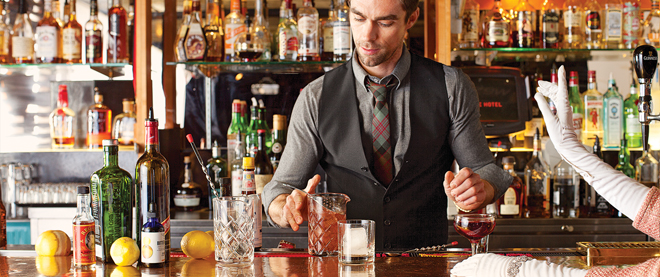Do you drink Dubonnet? The Queen does.
This ‘old lady’ apertif packs a punch and is perfect for toasting the Diamond Jubilee
Photograph by Reena Newman
Share

As events ramp up for the Diamond Jubilee, you might want to raise a glass to Elizabeth Alexandra Mary’s 60 years as Queen. But should you choose a British ale? What about a scotch, given that one of her residences, Balmoral Castle, is in Aberdeenshire? Or perhaps a drink mixed with the very British Pimm’s No. 1 Cup?
How about toasting the Queen with her favourite drink: a very French aperitif by the name of Dubonnet, which she enjoys with a shot of gin. It’s a habit passed down by the Queen Mother, who once sent a note to her favourite page, William Tallon, asking him to be sure to include “two bottles of Dubonnet and gin” for a picnic “in case it [was] needed.” We know this because the note was sold to an anonymous bidder for $25,000 at an auction of Tallon’s royal mementoes in 2008.
The Queen’s tipple packs a powerful punch, since Dubonnet contains 19 per cent alcohol by volume, and gin has 40 per cent. But don’t think the Queen is a boozer. “I’ve seen the Queen with this red drink on many occasions and she makes it last a whole reception,” says Arthur Edwards, a 35-year veteran photographer of the British royalty with the Sun newspaper in London. The Queen’s cocktail has been the brunt of many a joke from an anonymous tweeter who goes by the handle Elizabeth Windsor and assumes the persona of a boozy queen. @Queen_UK has amassed 600,000 followers, and even published a book called Gin O’Clock last year, doling out tweets such as “Giving up gin for lent. #kidding,” and, “Someone get one a gin and tonic. No tonic.”
If you have never heard of Dubonnet, that’s because it’s absolutely ancient and quite out of fashion. It was invented in 1846 by a Parisian chemist named Joseph Dubonnet, reportedly to help French Legion soldiers fight malaria in North Africa. The fortified wine contains herbs, spices and quinine, the malaria-fighting but very bitter ingredient that gives Dubonnet a bit of an edge. Served straight, Dubonnet has a viscous mouth feel and a spicy, fruity taste; something like Campari meets sweet vermouth. If it sounds old school, rest assured it is. Jen Agg, owner and bartender of Toronto’s Black Hoof restaurant and its annex, the Cocktail Bar, says people just don’t drink it anymore. “People think of Dubonnet as an old-lady drink, which I suppose is appropriate. The Queen is an old lady,” says Agg.
Just don’t tell that to Donna Alsop, owner of Henry House restaurant in Halifax. “I love it,” she says, adding that she picked up the habit of having a Dubonnet on the rocks in 1974 when she was living—where else?—in England. Dubonnet likely had its heyday in Paris’s belle époque, when its commercial posters were drawn in French art-nouveau style by artists like Adolphe Mouron Cassandre and Henri de Toulouse-Lautrec. In the ’70s, the French beverage company Pernot Ricard bought the Dubonnet brand, which had its last major advertising campaign about 30 years ago. It featured actress and singer Pia Zadora in TV commercials as the Dubonnet girl, singing and dancing to a tune that featured the lyric, “Do you Dubonnet?”
It may be past its prime, but Dubonnet bottles are not gathering dust. In Ontario, Dubonnet is the top-selling bottle in the limited niche of aperitifs. Perhaps price is its main selling point. A bottle of Dubonnet goes for just over $10, while comparable Italian aperitifs like Aperol and Cynar will cost more than twice as much. Jay Jones, the lead bartender at Shangri-La Hotel in Vancouver, says it is a shame Dubonnet faded away, and appreciates that the Queen drinks hers with gin. “It’s a classic cocktail, it just gets overlooked by modern drinkers and bartenders,” he says.
Robert Large, the yeoman of the royal cellars—that’s British for royal sommelier—mixes the Queen’s cocktail by adding one third London dry gin to two thirds of Dubonnet, topped with a thin lemon slice and two rocks of ice, as he demonstrated in a 2007 BBC documentary. It’s a cocktail fit for any subject who wants to drink like the Queen.